-
Paper Information
- Paper Submission
-
Journal Information
- About This Journal
- Editorial Board
- Current Issue
- Archive
- Author Guidelines
- Contact Us
American Journal of Systems Science
2015; 4(1): 11-26
doi:10.5923/j.ajss.20150401.02
What is Systems Thinking? A Review of Selected Literature Plus Recommendations
Jamie P. Monat, Thomas F. Gannon
Worcester Polytechnic Institute
Correspondence to: Jamie P. Monat, Worcester Polytechnic Institute.
| Email: |  |
Copyright © 2015 Scientific & Academic Publishing. All Rights Reserved.
Systems Thinking is a popular current topic in the world of Systems Engineering. However, as yet there is no commonly accepted definition or understanding of it. In this paper, we analyze some of the popular Systems Thinking literature and attempt to identify common themes. We conclude that Systems Thinking is a perspective, a language, and a set of tools. Specifically, Systems Thinking is the opposite of linear thinking; holistic (integrative) versus analytic (dissective) thinking; recognizing that repeated events or patterns derive from systemic structures which, in turn, derive from mental models; recognizing that behaviors derive from structure; a focus on relationships vs components; and an appreciation of self-organization and emergence. Specific Systems Thinking tools include systemigrams, system archetypes, main chain infrastructures, causal loops with feedback and delays; stock and flow diagrams; behavior-over-time graphs, computer modeling of system dynamics, Interpretive Structural Modeling (ISM), and systemic root cause analysis.
Keywords: Systems Thinking
Cite this paper: Jamie P. Monat, Thomas F. Gannon, What is Systems Thinking? A Review of Selected Literature Plus Recommendations, American Journal of Systems Science, Vol. 4 No. 1, 2015, pp. 11-26. doi: 10.5923/j.ajss.20150401.02.
Article Outline
1. Introduction
- Systems Thinking has its foundation in General Systems Theory (Bertalanffy) and has been applied to a wide range of fields and disciplines. It has great power in solving complex problems that are not solvable using conventional reductionist thinking. It can be used to explain dynamic non-linear behaviors like market reactions to new product introductions or predator-prey relationships; to understand complex socio-economic problems such as the effects of marijuana laws; and to understand the seemingly illogical behaviors of individuals, countries, and organizations such as ISIS’s provocative actions. However, many systems engineers do not fully grasp Systems Thinking—many believe it is simply the fundamental concepts of Systems Engineering as articulated by Kossiakoff et al. and Blanchard and Fabrycky, comprising V-diagrams, risk management, needs analysis, architecture and design, integration and test, and project management. This is not the case. Some practitioners have co-opted the term “Systems Thinking” to include all aspects of systems including general systems theory, cybernetics, family therapy, and Model-Based Systems Engineering (MBSE). We think this inappropriate. The Systems Engineering Body of Knowledge devotes a chapter to Systems Thinking. However, this chapter is a compendium of literature articles on systems thinking concepts, principles, and patterns. It is quite vague and does not appear to integrate the disparate articles into a cohesive whole. Furthermore, several key references (Meadows, Kim, Richmond) have been omitted. The dozens of books and articles written on Systems Thinking have some common threads, but different focuses and interpretations. In this paper we attempt to make sense of this chaos and develop a firm conceptual framework for Systems Thinking.
2. Literature Review
- We do not purport to have done a comprehensive analysis of all systems thinking literature. We selected approximately 30 of the more popular works; works that we interpret to be “key” contributors to the understanding of systems thinking and that had “systems thinking” in either their title or subject description. To ensure that we had not missed any key references, we then submitted this list to 14 published experts in the field of Systems Thinking and asked for their suggestions regarding relevant literature; 9 of them (acknowledged at the end of this paper) were kind enough to reply with suggestions. We then evaluated their suggestions and added those that we believe advance the understanding of systems thinking (we did not include references focused on other aspects of systems, such as systems engineering, sources describing primarily predecessors to or precursors of systems thinking, or items that addressed sub-sub-elements of systems thinking such as the details of system dynamics programming.) The result is an edited list of approximately 33 references that we deem important to the understanding of systems thinking. These references are organized into 4 categories: Introductory Works, Applications of Systems Thinking, Self-organization and Emergence, and General Works.Introductory Works• Kim, Daniel H., Introduction to Systems Thinking. This 20-page booklet is probably the best concise introduction to systems thinking that is available. All of the basics are covered, including the definition of a system, the systems thinking “Iceberg Model,” and systemic behavior including feedback loops and delays. The Iceberg Model argues that in a system, repeated events represent patterns and that patterns are invariably caused by systemic structure. In human-designed systems, systemic structure develops as a result of mental models. If one could read only one work to get a good grasp of Systems Thinking, this would be it.• Richmond, Barry, An Introduction to Systems Thinking with iThink. iThink and Stella are 2 excellent system dynamics modeling software packages available from isee systems of Lebanon, NH. This instruction manual for these packages does much more than explain how to use the software; it is in fact a primer on systems thinking, covering such topics as system dynamics, feedback loops, stock-and-flow diagrams, main chain infrastructures, mental models, and non-linear effects. The most excellent aspect of this book, however, is its ability to relate everyday real-world situations to a systems thinking perspective. It is a terrific resource, whether one uses the software or not. Richmond includes a definition of Systems Thinking: “… systems thinking is the art and science of making reliable inferences about behavior by developing an increasingly deep understanding of the underlying structure.” • Meadows, Donella H., Thinking in Systems: A Primer. In our opinion, this is the seminal work on systems thinking. It was published posthumously from Dana Meadows’s notes. It covers system definition, stock and flow diagrams, feedback loops, resilience in systems, hierarchies, self-organization, unintended consequences, the 10 systemic archetypes, system leverage points, and rules for systems. However, it does a superb job in using real world examples (such as the inadvertent impact of DDT on bird eggshell thickness and the folly of spruce budworm control) to make its points. No student of systems thinking should miss this book.• Anderson and Johnson, Systems Thinking Basics, from Concepts to Causal Loops. This relatively short book is a good study guide for introductory students of systems thinking. It is consistent with Kim, Meadows, and Richmond and covers the Iceberg Model, causal loop diagrams, archetypes, and behavior-over-time graphs. The book defines systems thinking as a set of tools (includes a “palette of systems thinking tools”, a framework for looking at issues, and a language. It is somewhere between Kim and Meadows in its level of detail and examples.Kauffman, Systems One: An Introduction to Systems Thinking. This relatively early (1980) 40-page pamphlet is a concise introduction to the field. It discusses stability and feedback in systems, complexity, and archetypes, and it gives good examples of causal loop diagrams involving float valves, predator-prey relationships, thermostats, crime and punishment, compound interest, growth of power, and growth of knowledge. It is consistent with Meadows, Kim, Richmond, and Anderson and Johnson, but it does not discuss the Iceberg Model or dynamic modeling; it is thus less comprehensive than some other sources.• Sweeney and Meadows, The Systems Thinking Playbook. This book attempts to teach many systems thinking principles through the use of games. It focuses on “habits of mind” --- identifying and then breaking them. Unfortunately, many of the games are sophomoric and don’t make the points well. One exception is “Avalanche” in which several people try to lower a hula hoop simultaneously while supporting the hoop with just one finger. Contrary to everyone’s mental model, the hoop goes up instead of down. This is an excellent demonstration of incorrect mental models and how they can dominate behavior. The book in general, however, falls short of teaching systems thinking principles via games.• Galley, Think Reliability: Investigation Basics — The Systems Approach. This is a very good short article explaining how systems thinking enhances conventional root cause analysis. It argues that Systemic Root Cause Analysis should not identify a single root cause, but instead a root cause system: a paradigm, culture, environment, or set of attitudes that yield the specific identifiable causes. The sinking of the Titanic is used as an example.• Aronson, An Overview of Systems Thinking, (http://resources21.org/cl/files/project264_5674/OverviewSTarticle.pdf). This article provides a good summary of how systems thinking is fundamentally different from reductionist thinking. It provides an example of how pesticides used to control insect damage to crops can give rise to alternative predatory insect damage that was not previously envisioned as an unintended consequence.• Goodman, Kemeny, and Roberts, The Language of Systems Thinking: ‘Links’ and ‘Loops’. This article provides a brief tutorial on the use of causal loops and delays to represent system behavior over time. It illustrates how they can be used to model the ups and downs of sales cycles, exponential growth or collapse in investment strategies, and stabilization in the number of patient visits to an outpatient clinic.• Lawson, A Journey Through the Systems Landscape. The Lawson book discusses system classification and topologies as well as the Iceberg Model. It gets into systems archetypes, causal loop diagrams, system life cycles, and decision analysis, and it includes several good case studies involving crisis management, organizational development, architectural concepts, and ontology life cycle management. It is a good book and consistent with Meadows, Kim, and Richmond.• Weinberg, An Introduction to General Systems Thinking. Weinberg presents several interesting and useful systems thinking concepts; among them the following plot (Figure 1) of Randomness versus Complexity, showing where systems (organized complexity) fit (a surprisingly large area of the plot.) (The original concepts of simplicity, organized complexity, and unorganized complexity are attributable to Weaver (1948)).
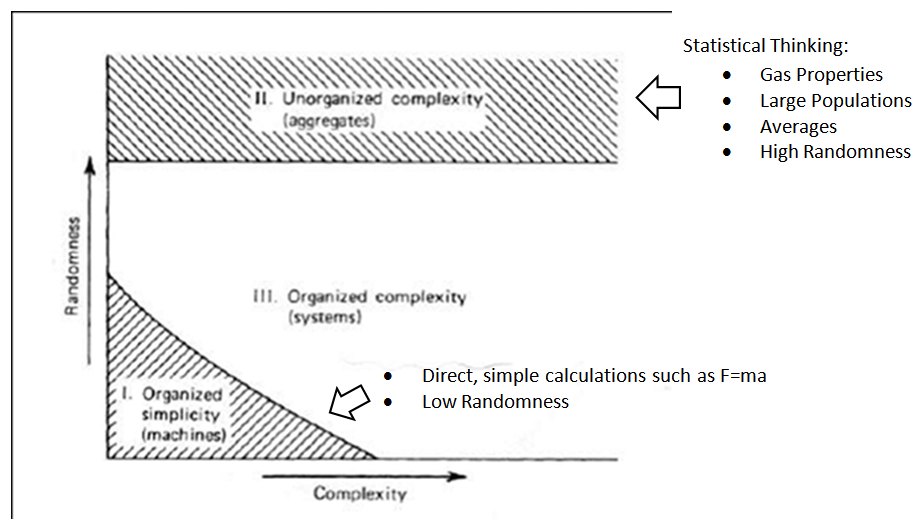 | Figure 1. Weinberg’s Systems Map of Randomness versus Complexity |
3. What is Systems Thinking? --- Recommendations
- There are many different views regarding the definition of Systems Thinking, and as yet there does not seem to be a precise, widely-accepted definition. However, there appear to be common themes that are repeated in many of the sources. This section will attempt to identify and integrate those common themes into a coherent definition.
 The Systems Thinking Perspective Most sources agree that systems thinking is the opposite of linear thinking, and that it focuses on the relationships among system components, as opposed to the components themselves. It is holistic (integrative) thinking instead of analytic (dissective) thinking. The scientific method prevalent in the last 2 centuries has taught us that we must break up complex situations into smaller and smaller pieces to understand them: dissective thinking. While this has great benefits, it also has the great disadvantage of ignoring the relationships among system components; those relationships often dominate systems behavior. Systems thinking requires that we study systems holistically. This holistic thinking involves both spatial and temporal elements, as shown in Figure 2.
The Systems Thinking Perspective Most sources agree that systems thinking is the opposite of linear thinking, and that it focuses on the relationships among system components, as opposed to the components themselves. It is holistic (integrative) thinking instead of analytic (dissective) thinking. The scientific method prevalent in the last 2 centuries has taught us that we must break up complex situations into smaller and smaller pieces to understand them: dissective thinking. While this has great benefits, it also has the great disadvantage of ignoring the relationships among system components; those relationships often dominate systems behavior. Systems thinking requires that we study systems holistically. This holistic thinking involves both spatial and temporal elements, as shown in Figure 2. | Figure 2. Systems Thinking versus Traditional Views |
 | Figure 3. Systems Thinking Complements Analytic and Statistical Thinking |
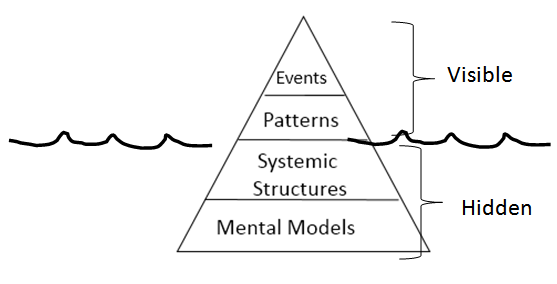 | Figure 4. The Iceberg Model |
 | Figure 5. The Iceberg Model Applied to Natural versus Human-Designed Systems |
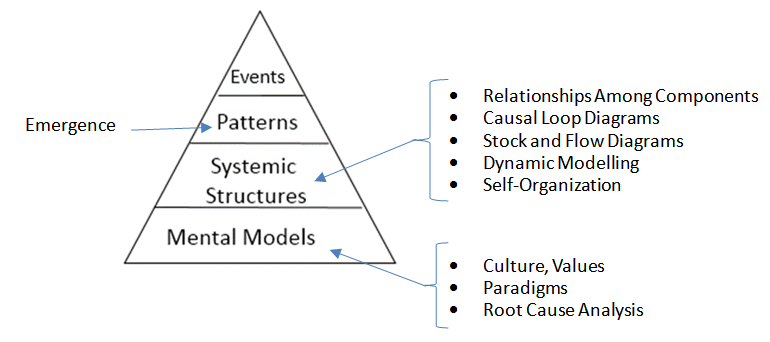 | Figure 6. Integrated Model of Systems Thinking |
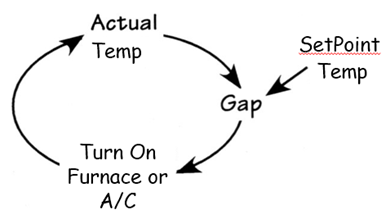 | Figure 7. A Simple Causal Loop Diagram |
 | Figure 8. A Simple Stock-and-Flow Diagram (from Meadows) |
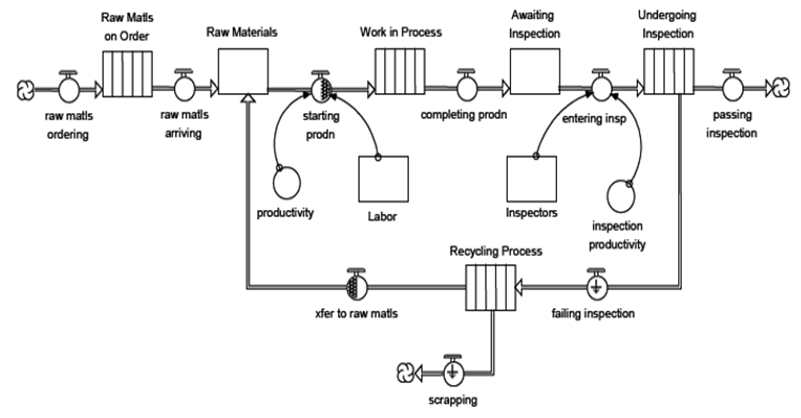 | Figure 9. Manufacturing Main Chain Infrastructure (from Richmond) |
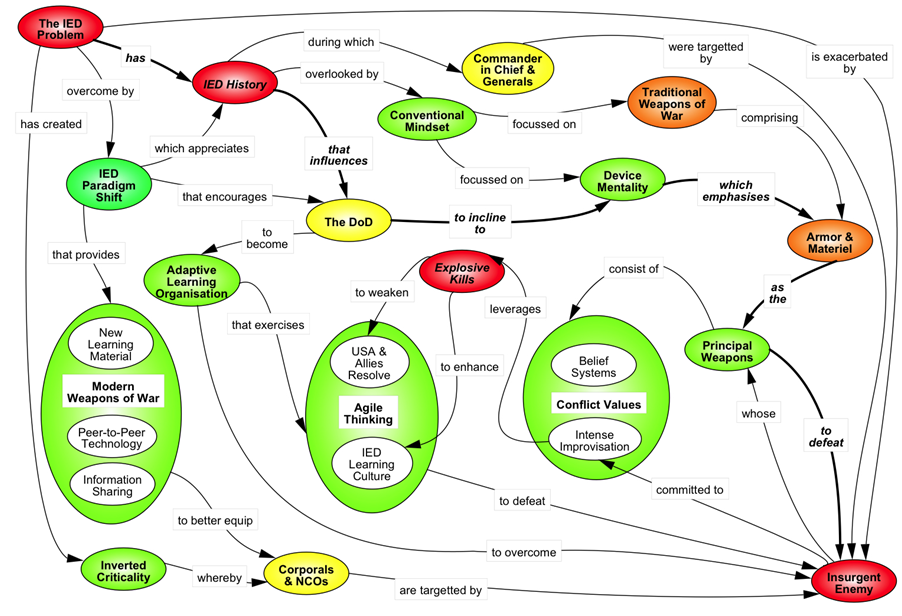 | Figure 10. IED Systemigram (from Sauser) |
4. Conclusions
- There is a good deal of literature about Systems Thinking presenting a variety of concepts and viewpoints, many of which are disparate. In this paper we have reviewed some of the key literature and attempted to identify common threads and integrate them into a coherent definition. Systems thinking is 1) a perspective that recognizes systems as collections of components that are all interrelated and necessary, and whose inter-relationships are at least as important as the components themselves; 2) a language centered on the Iceberg Model, unintended consequences, causal loops, emergence, and system dynamics, and 3) a collection of tools comprising systemigrams, archetypes, causal loops with feedback and delays, stock and flow diagrams, behavior-over-time graphs, main chain infrastructures, system dynamics/computer modeling, interpretive structural modelling, and systemic root cause analysis.Systems Thinking provides a great deal of power and value. It can be used to solve complex problems that are not solvable using conventional reductionist (dissective) thinking, because it focuses on the relationships among system components, as well as on the components themselves; those relationships often dominate system performance. It focuses on the properties of the whole that are neither attributable to nor predictable from the properties of the components. Systems Thinking can be used to explain and understand dynamic non-linear behaviors like the inventory oscillations in supply chain management and the populations of predators and their prey; it can be used to understand complex socio-economic problems, predict behaviors, and identify leverage points (e.g. the instability in Afghanistan and the failure of drinking water systems in Togo); and it can be used to explain and understand the apparently illogical behaviors of individuals, organizations, and even countries (such as the rationale behind John Hinckley’s attempted assassination of President Reagan, ISIS’s apparently self-destructive behavior, and the failure of Research In Motion to remain competitive in the Smart Phone industry.)
5. Future Work
- The real measure of any definition of Systems Thinking is its ability to help understand and address systems issues. Future papers will investigate the application of the above-described description of systems thinking to real-world problems such as root cause analysis of the space shuttle “Challenger” disaster and of the Penn State sex abuse scandal, the demise of Research In Motion, Inc. and of Polaroid, Inc., how to deal with ISIS, the decline of the fin fishing industry off the coast of New England vs the success of Maine’s lobster fishing industry, the failure of our domestic drug policies, the British Petroleum Gulf of Mexico oil spill, the 2008 U.S. economic bailout, and the success of Emperor Palpatine of Star Wars.
ACKNOWLEDGEMENTS
- We would like to thank the following for their suggestions regarding key systems thinking literature and an optimal approach in analyzing the references: Gene Bellinger, Bob Cavana, Heidi Davidz, Jamshid Gharajedaghi, Michael Goodman, Derek Hitchins, Harold “Bud” Lawson, Donna Rhodes, and Jerry Weinberg.
 Abstract
Abstract Reference
Reference Full-Text PDF
Full-Text PDF Full-text HTML
Full-text HTML